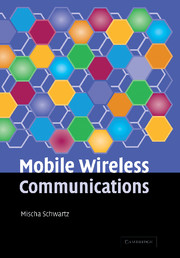Book contents
- Frontmatter
- Contents
- Preface
- 1 Introduction and overview
- 2 Characteristics of the mobile radio environment–propagation phenomena
- 3 Cellular concept and channel allocation
- 4 Dynamic channel allocation and power control
- 5 Modulation techniques
- 6 Multiple access techniques: FDMA, TDMA, CDMA; system capacity comparisons
- 7 Coding for error detection and correction
- 8 Second-generation, digital, wireless systems
- 9 Performance analysis: admission control and handoffs
- 10 2.5G/3G Mobile wireless systems: packet-switched data
- 11 Access and scheduling techniques in cellular systems
- 12 Wireless LANs and personal-area networks
- References
- Index
12 - Wireless LANs and personal-area networks
Published online by Cambridge University Press: 05 June 2012
- Frontmatter
- Contents
- Preface
- 1 Introduction and overview
- 2 Characteristics of the mobile radio environment–propagation phenomena
- 3 Cellular concept and channel allocation
- 4 Dynamic channel allocation and power control
- 5 Modulation techniques
- 6 Multiple access techniques: FDMA, TDMA, CDMA; system capacity comparisons
- 7 Coding for error detection and correction
- 8 Second-generation, digital, wireless systems
- 9 Performance analysis: admission control and handoffs
- 10 2.5G/3G Mobile wireless systems: packet-switched data
- 11 Access and scheduling techniques in cellular systems
- 12 Wireless LANs and personal-area networks
- References
- Index
Summary
Previous chapters in this book have focused on cellular wireless networks. These were originally developed for voice use almost exclusively, as extensions of the wire-based telephone networks worldwide. Second-generation systems have been tremendously successful in this regard, with the number of cellular users expanding at a remarkable rate throughout the world. As noted in Chapter 10, data traffic on these cellular networks has been slower to develop. Higher-capacity third-generation systems discussed in that chapter have been designed specifically to handle packet-switched data. Wireless local-area networks, WLANs, have been developed as well to handle data traffic and have been proliferating worldwide. It is these networks and their even-smaller relatives, personal- area networks, that we discuss in this last chapter.
More specifically, we discuss in Section 12.1 the widely popular IEEE 802.11 and 802.11b wireless LAN standards, running at transmission rates of up to 11 megabits per second (11 Mbps) over the 2.4 GHz unlicensed frequency band. We treat briefly as well the newer very-high bit rate WLAN standards IEEE 802.11g and 802.11a running at rates up to 54 Mbps over the 2.4 GHz and 5 GHz unlicensed bands, respectively. The 802.11g standard is specifically designed to support extension of the 802.11b LAN standard to much higher bit rates over the same band. In Section 12.2 we then discuss wireless personal-area networks, focusing on the Bluetooth system, standardized as IEEE 802.15.1. The IEEE 802.11b standard has also been dubbed “Wi-FI” and is frequently referred to as the wireless Ethernet.
- Type
- Chapter
- Information
- Mobile Wireless Communications , pp. 395 - 433Publisher: Cambridge University PressPrint publication year: 2004



